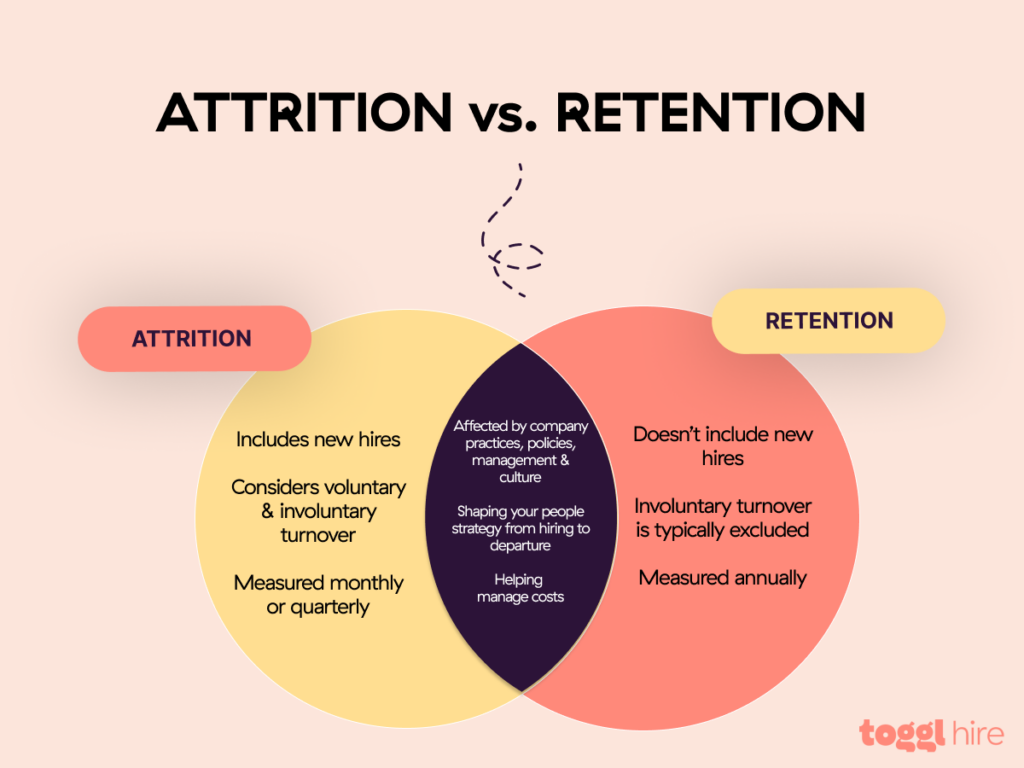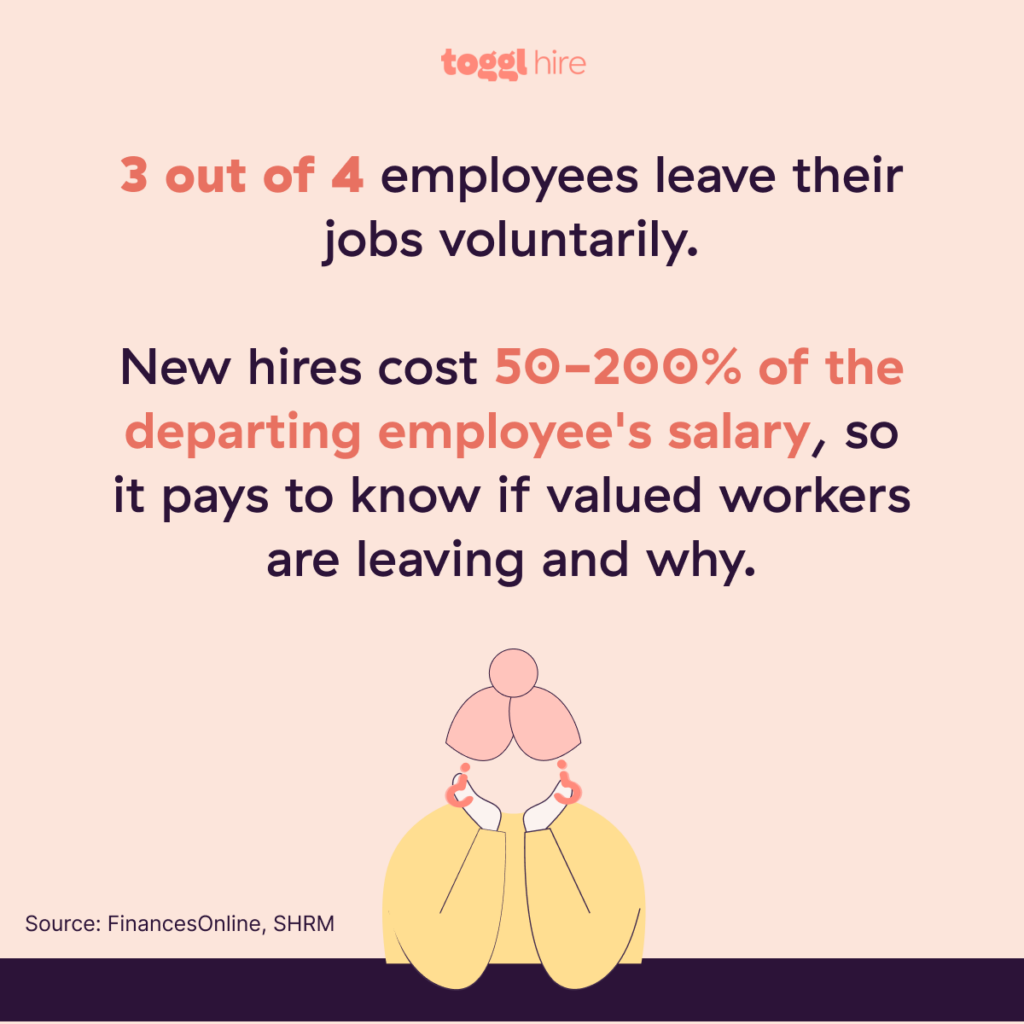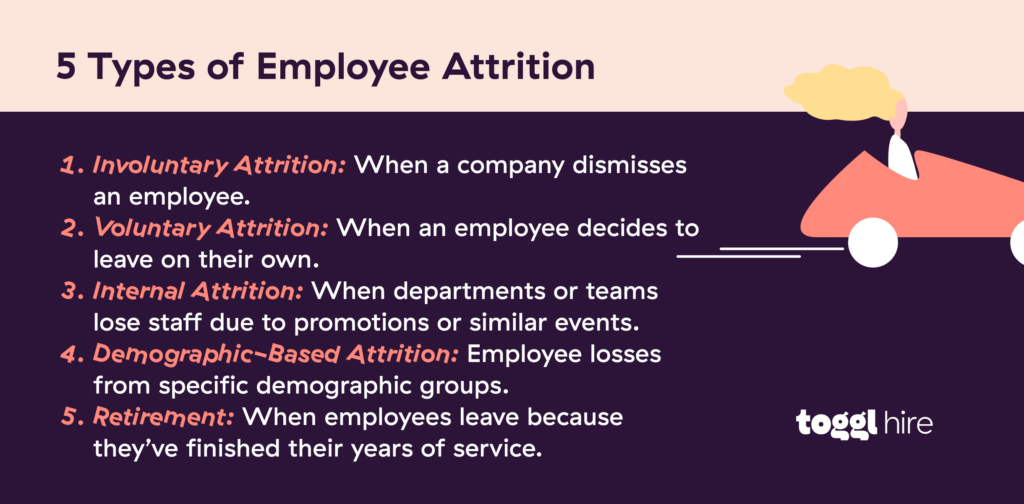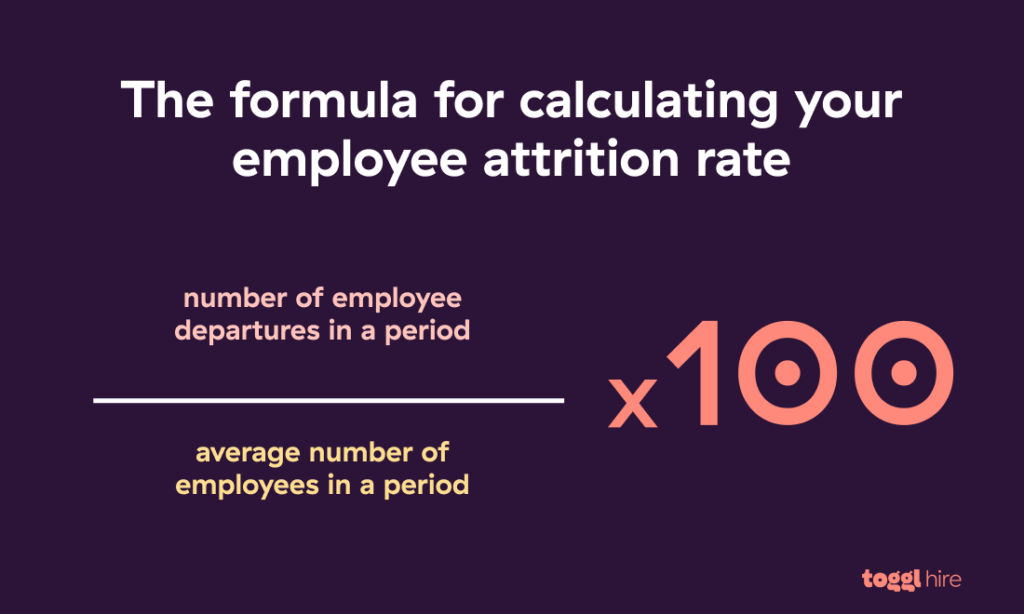Even in the most stable organizations, employees come and go. In the best of caes, companies take advantage of those changes to close skills gaps and hire unique leaders while retaining employees they can’t live without.
However, it’s all too easy to lose control of employee churn, otherwise known as attrition rate. And when employee attrition runs too high, organizations leak skills without replacing them. Teams slowly lose their vitality, and the company adapts too slowly to emerging challenges.
Eventually, excessive attrition and poor retention will undermine any firm’s competitive position. But here’s the thing: How do you know when you face a workforce crisis? And when can you let natural attrition take its course?
Take a deep breath and get ready to explore the answer.
TL;DR — Key Takeaways
Employee attrition happens when employees leave an organization without being replaced. Attrition contrasts with turnover, which measures the number of people leaving or getting fired from an organization only to be replaced by other workers.
Calculating your employee attrition rate provides valuable information about workforce change and challenges. A high attrition rate isn’t always cause for anxiety. However, steadily losing talent and experience can have serious consequences.
Labor statistics reveal attrition has many causes. Workers may retire without being replaced, talent could migrate to better-paid work or companies with brighter career prospects, or workers may leave due to cultural issues such as discrimination or poor management.
It’s important to take action to reduce excessive attrition rates. Solutions include flexible working, raising pay, providing benefits, or upskilling employees. Better recruitment can also help with employee retention.
What is employee attrition?
Employee attrition refers to situations when companies don’t replace employees as they leave the organization. Attrition can be deliberate and part of planned payroll downsizing strategies. However, it can also be unplanned, suggesting underlying problems with staff happiness and employee retention.
Analysts generally use a metric called the attrition rate to capture fluctuating employee numbers. This rate tells HR teams how their workforce composition changes over a given period.
In theory, managers can use the attrition rate to detect problem areas and schedule recruitment. Alternatively, an organization’s attrition rate may verify that downsizing is going well. Either way, it’s an important metric that companies must calculate and deploy intelligently.
Employee attrition vs. employee turnover
It’s rare that any organization’s workforce demographics remain exactly the same year over year. Employees resign or retire, and departments grow or shrink according to business strategy. The challenge is understanding why these changes are happening and how to respond.
That’s why employee attrition and employee turnover are all-important. And while we’re on the subject, it’s important to note that these concepts are closely related but far from identical, even if people sometimes use them interchangeably.
As we learned earlier, the employee attrition rate measures people leaving a company without being replaced. Turnover measures the rate at which employees leave a business but are replaced.
We usually measure employee turnover annually, capturing short-term changes in workforce roles. Attrition occurs over longer periods. Analysts track attrition rate fluctuations over years (or even decades in larger organizations).
HR professionals use turnover rate and attrition rate differently, too. Measuring the turnover rate can help you hire new employees and maintain skill levels. Measuring attrition rate helps with long-term planning, allowing HR teams to identify areas where expertise is lacking.

Why does your attrition rate matter?
Measuring your attrition rate matters for many reasons — not least because retaining high-quality employees is critically important. Organizations simply can’t succeed if they gradually lose their best employees to retirement or resignation without arranging suitable replacements.
Beyond the ability to retain employees and foster company growth, there are plenty of reasons to focus on lowering the attrition rate in your HR operations:
Institutional knowledge: Organizational or institutional knowledge keeps processes running smoothly. Company cultures rest on years of experience and the accumulation of personalities that complement each other. Losing too many employees can disrupt this balance.
Restructuring: Measuring attrition makes it easier to manage restructuring processes without losing valuable employees. Planners can make wholesale organizational changes by evaluating any suspicious upticks in employee departures and addressing the underlying issues causing them.
Cost savings: Hiring employees isn’t cheap. New hires cost 50-200% of the departing employee’s salary, and that’s without factoring in the cost of disruption as teams change and managers leave. It pays to know if valued workers are leaving and, most importantly, why.
Burnout and disaffection: Employee happiness promotes long-term success. High attrition rates may suggest low job satisfaction or excessive workloads. As workers leave, colleagues can become overburdened, making the burnout problem even more severe.
Damage to your employer brand: Stable workforces imply that internal teams are well-managed and harmonious. Outsiders want to join companies that boost their long-term prospects and treat them well, and high attrition rates dissipate this harmony.
Better recruitment: High attrition rates could indicate poor recruitment practices. A steady outflow of talent may be due to poor hiring processes. Identifying this trend lets you take action and audit hiring processes.

Five different types of attrition
Attrition isn’t always something to worry about. Employees often leave for normal reasons such as retirement or moving to a different city. Companies should anticipate a baseline level of attrition.
Problems arise when the attrition rate rises above that normal level. That’s when you need to act. However, it’s vital to understand what drives attrition before taking action. HR teams must identify whether attrition is normal or evidence of a brewing crisis.
With that in mind, we recommend using the five types of attrition listed below to diagnose issues and make the right hiring decisions.
Voluntary attrition
This type of attrition involves employees deciding to leave their positions and has many possible root causes.
For example, voluntary attrition could indicate deep-seated problems with company culture, employee benefits, or salaries. Employees may leave to find better working conditions or professional growth options.
Then again, voluntary attrition isn’t always concerning. Staff could decide to move elsewhere, or workers might leave as their family situation changes. Often, employees make a career switch for reasons with nothing to do with your company.
Involuntary attrition
Unsurprisingly, involuntary attrition is the opposite of voluntary attrition. In this case, companies decide to reduce their headcount by dismissing employees.
Involuntary attrition can be cause for concern. For instance, regularly dismissing employees for poor performance or personal reasons suggests problems with hiring or workplace management.
On the other hand, companies often dismiss workers as part of deliberate restructuring processes. Headcounts often fall during times of economic stress. If that’s the case, managers must decide whether losing talent is a sensible way to cut costs or a short-sighted and damaging response.
Internal attrition
Attrition doesn’t always involve the organization as a whole losing employees. Internal attrition involves departments, local offices, or teams losing staffers over time.
Many dynamics could be at play. Sometimes, employee cohorts climb the management ladder, leaving gaps at junior levels. This can happen when companies hire in bursts and don’t manage succession competently. But it can also be a positive sign. After all, employees are rising and succeeding, and that’s exactly what should happen in thriving companies.
In other cases, mismanagement or diminished career development prospects might make certain departments unappealing. Measuring internal attrition makes it possible to identify misfiring parts of a company that aren’t contributing to overall success.
Demographic-based attrition
Demographic-specific attrition measures employee losses from different demographic groups. For example, HR teams might collect data on attrition rates for women, different age groups, disabled employees, or employees from ethnic minorities.
This attrition metric is valuable because it highlights internal problems. High demographic-specific attrition for certain groups may indicate cultural issues such as discrimination, insensitive management, or even harassment.
Retirement
Retirement has features of involuntary and voluntary attrition. Retirement after years of service is often positive for individuals and companies. Because it’s often planned, HR teams can plan succession and update skills or competencies as retirees leave.
However, rising early retirement rates could indicate problems for mid to late-career individuals. Early retirement could be evidence of low employee morale or poor treatment of older workers. Losing those workers can cost you invaluable employee experience.

How to calculate attrition rate
Calculating attrition rates requires a little computation, but if you’re not a fan of numbers, don’t freak out — the attrition rate formula is relatively simple. Nevertheless, let’s explain the components involved and how the attrition rate formula works; just follow these five steps:
First, gather data on the size of the workforce (or the department you’re assessing). Record this total at the start of a given period. This period usually lasts for one year to create an annual attrition rate.
During the recording period, track:
How many employees leave
How many employees you hire
When the period ends, subtract the number of hires from the number of employees departing and add that to the employee total. This gives a year-end number of employees.
Add the number of employees at the start of the year and the year-end total. Divide this by two to arrive at an average number of employees.
Finally, divide the average headcount by the number of employees who depart. Multiply this by 100 to get your annual attrition rate.
Take an imaginary company with 1,500 employees. Over a year, 200 staff leave and 300 arrive. At year’s end, the headcount is 1,600, and the average number of employees is (1,500+1,600)/2 or 1,550. This creates an attrition rate of (200/1,550)x100 – or 12.9%.
Or, to simplify things: a company’s attrition rate = attritions/average number of employees x 100.

What’s a good annual attrition rate?
In the example above, the company’s attrition rate was 12.9%. But is that good or bad? The answer depends on the context.
The first thing to remember is that higher attrition rates show rapid employee churn. Lower rates suggest that workforces are stable with few arrivals or departures. Rates under 20% are generally fine (or even healthy). Anything above that level should raise an alarm bell or at least warrant further analysis.
However, this is just a simplification. In reality, attrition rates vary between sectors and sizes of companies. One study of firms in the Culture 100 index found 2-30% attrition rates.
Rates have also recently been higher in some sectors. Healthcare and the hospitality industry tend to record higher attrition, while engineering is more stable. Attrition rates also vary between regions and countries. For instance, research in the UK suggests a 20% staff attrition rate in 2023, compared with 18% in the USA or 23% in Germany.
It’s always best practice to compare your metrics with norms across your region and industry.
You should also check for short and long-term attrition and also measure attrition rates of specific groups of employees, like new hires or senior leaders. Attrition rates of 15% across the whole company may be fine. However, if 15% of new hires leave in their first year, you’ve got problems. It pays to drill down into attrition data to obtain insights about employee groups. An enterprise-wide perspective can be misleading.
Causes of a high attrition rate
Companies with high attrition rates shouldn’t panic. However, finding the roots of attrition is important in reducing it.
Attrition often has mundane causes. For instance, companies often recruit large groups of similar employees. When those cohorts retire or move to more senior roles at the same time, it causes a spike in the attrition rate. In this case, that spike isn’t evidence of pressing internal issues.
Situations like this are also avoidable by planning recruitment around the employee lifecycle. However, some other preventable causes of attrition require urgent attention. Here are a few “worrying” reasons for a high attrition rate that you would want to explore further.
Low pay
According to the Pew Foundation, low pay was the number one reason given by workers who quit their jobs in 2021. Stats also suggest that employee turnover rises by 28% for every $1 wage reduction. That’s not surprising. Underpaid employees choose alternative employers offering better rewards or benefits. If this happens slowly, it’s sure to show up in attrition rate figures.
Lack of growth opportunities
Valued employees melt away if they become frustrated at the lack of career advancement. Workers who can’t visualize progression at their current workplace are 61% more likely to quit, while 40% of departing employees cite a lack of opportunities as their primary motivation.
Poor company culture
In notorious cases (like Twitter), erratic leadership and poor company culture spark a swift exodus. Other times, managerial drift and constant low-level discrimination push employees to depart. Maintaining a healthy culture where employees feel comfortable, supported, and included maximizes your chances of retaining top performers for as long as possible.
Burnout
Burnout is always something to watch out for, but it’s especially pressing for larger organizations. HR teams at companies with over 2,500 employees report that boredom and burnout account for 50% of annual employee attrition. Stress, poor interpersonal relationships, overwork, and lack of challenge all contribute to employee burnout.
Skills mismatch
Sometimes, people leave because employers don’t harness their skills effectively. According to the OECD, around 40% of worker roles don’t match the occupant’s qualifications. Most workers aren’t receiving training to solve this problem, while 69% of human resources professionals report skills gaps in their organizations.
The result? Unhappy workers who are constantly looking for better places to deploy their skills. Rising employee attrition rates could be evidence of a skills mismatch. Assess recruitment analytics and use skills tests to identify capabilities and improvement areas. Smart training and skills analysis could stabilize workforce turnover and make employees more productive.
How to improve employee attrition rate
Have you identified what’s causing your company to experience such a high attrition rate? Great. That’s the first step. Now, the ideas below should help you reduce attrition and contribute to happier, more harmonious workplaces.
Review pay and benefits packages
Improving your employee value proposition is usually the best starting point here. One obvious win is boosting pay and benefits to ensure employee satisfaction. When pay rates fall below competitors, employees start to look elsewhere.
Boosting every employee’s annual salary has less visible employee retention benefits as well. Well-paid workers are better placed to handle difficult situations and stay engaged. High pay also shows that an organization values its workforce — boosting the employer brand and attracting talented recruits.
Use skills tests during interviews
Mismatched skills often lead to a high attrition rate. Companies need to ensure every recruit is well-suited to their future role in terms of hard and soft skills and cultural fit.
To ensure you’re hiring for the right skills, use skills assessment tests during the hiring process to evaluate candidates‘ abilities and qualities. Testing early in the recruitment process filters unsuitable candidates, making it easier to select individuals who have what it takes to succeed in your organization.

Offer learning and employee development opportunities
Poor personal development opportunities can cause a high attrition rate, and training is often the answer. Employees want pathways to develop their skills and rise the company hierarchy. Provide continuous training and invest in further study for valuable employees.
Personal development and promotion prospects do more than boost employee satisfaction. They encourage workers to buy into the company’s mission. Employees feel valued and empowered and become more confident and ambitious to contribute. Employee retention tends to rise as a result.
Consider flexible working arrangements
One Yoh study found that 44% of women and 39% of men would consider a new job with more flexible arrangements. Employees these days expect leeway about when and where they work, and being too strict can make your churn rate soar.
Ask employees whether flexibility is a core concern. If the response is generally “yes,” consider unique ways to balance office and remote work.
Upskill employees to hire internally
Upskilling is a good way to avoid involuntary attrition when economic conditions decline. Current employees could learn techniques like AI or customer relationship management. Given the cost of hiring new workers, looking internally is a smart move.
Strategic skills management also helps you handle voluntary attrition and succession. Schedule training programs that help upskill internal replacements as experienced employees retire. This avoids skills gaps and keeps operations running smoothly.
Conduct exit and stay interviews
As you’ve probably guessed by now, you can’t solve a high attrition rate without understanding employee needs. One of the best ways to gather information about employee attrition is by conducting exit and stay interviews.
Stay interviews ask current employees for feedback about what drives people to leave. Exit interviews ask similar questions to employees leaving the firm. Use the data from these interviews to identify patterns before your employee attrition rate becomes critical.
Attract and engage the right candidates
Two themes emerge when we zoom out and take a broader perspective on employee attrition.
On one hand, companies need to manage existing talent. Upskilling, flexible work, supportive leadership, and an inclusive company culture keep the employee attrition rate in check.
Recruitment and talent acquisition are also at play, though. Proactive approaches to acquiring talent make it far easier to prevent unhealthy attrition. New hires should have the skills needed to thrive in their roles, and they should be a snug fit for the company’s internal culture.
How do you strike that balance when hiring? Skills testing software helps you assess candidates for the right skills to make data-driven hiring decisions, thereby reducing the risk of costly mis-hires.
Take your hiring to another level with a free Toggl Hire account. Explore our skills test library to see how you can hire for the right skills, boost employee engagement, and ultimately reduce your company’s attrition rate.

Elizabeth is an experienced entrepreneur and content marketer. She has nine years of experience helping grow businesses and has experienced first-hand the impact of skills-based hiring in today's global, digital world.







